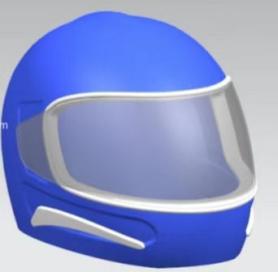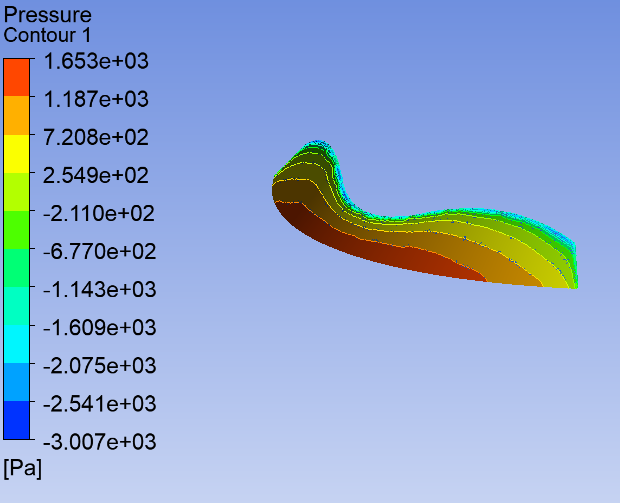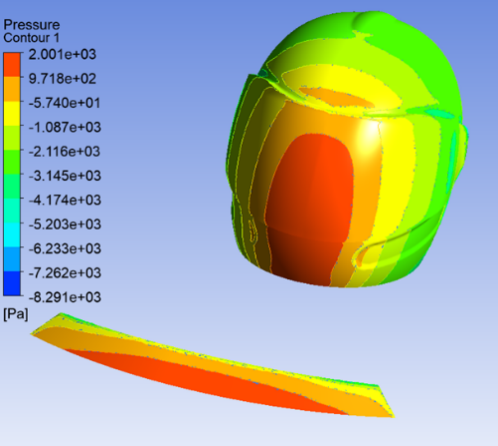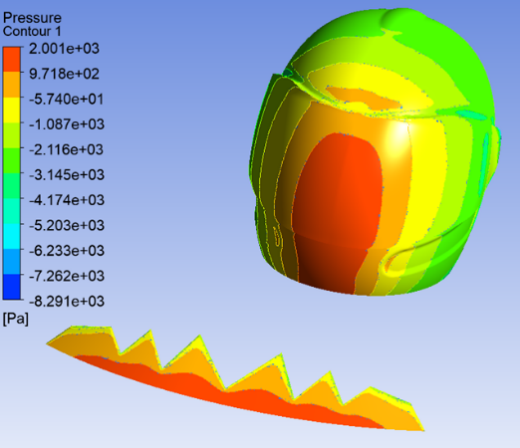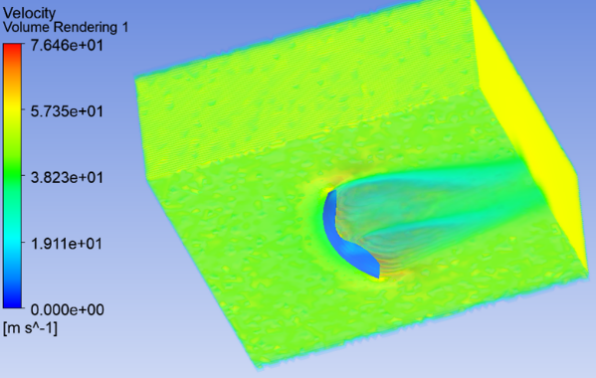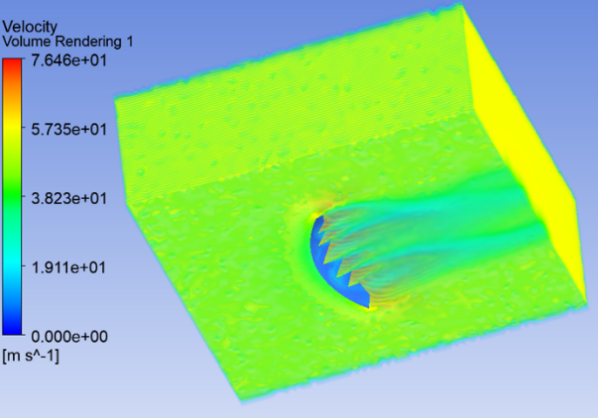1. Introduction
In Formula One (F1) cars, a small windshield sits directly in front of the driver's head. There is no definitive answer as to what the windshield is actually used for. There is little research on the small windshield used in F1 cars, so it is difficult to know what engineers intended when they designed it [1,2]. This paper fills the gap in this field, verifies whether the outside speculation about the effect of windshield on the driver's head is true, conducts a classification study on different shapes of windshield, explores the different effects of different shapes of windshield, and tries to give an optimization scheme. In this study, FLUENT is used to model the smooth, wavy, and the most common zigzag windshield as well as the driver's head. In addition, 200km/h air fluid is used to simulate the windshield and the driver's head. Finally the force influence of different shapes of windshield on the driver's head is discussed and a streamline analysis is conducted. This paper first analyzes the force on the windshield and the driver's head, then analyzes the fluid flow diagram, and finally gives the analysis results and some optimization schemes for the windshield. This study will help standardize the racing rules and promote similar designs to other fields [3,4].
2. Research background and outside speculation
2.1. Research background
A small and smooth-edged windshield was designed by F1 racing engineers a long time ago, being right in front of the cockpit. Unlike many common windshields, the design of the F1 racing car’s windshield appears out of place on the car, and the actual ability of the windshield has been questioned. With the development of the F1 racing car, the design of its windshield has also changed from the original smooth edges to wavy edges, and finally to the current jagged edges. The unusual design has further increased the outside world's doubts.

Figure 1. The windshield with zigzag edge (source from F1 fanatic.co.uk/pictures/new).
2.2. Outside speculation on the function of the windshield
Outside the mainstream view is that the function of the windshield is to improve the driver's head comfort, and protect the driver's head and neck in the race to bear the great weight. Engineers designed it to improve the rider's head comfort. In subsequent times, the smooth edges were changed to jagged shapes to better protect the driver's head. This paper also focuses on the influence of three different shapes of windshield on the driver's head comfort.
3. Modeling for different windshields and the driver's head
This research is based on the FLUENT to conduct simulation experiments on the driver's head and the windshield. The windshield is placed in front of the driver's head to simulate the real situation. The experimental model was simulated in a frontal wind tunnel with 200km/h air fluid to simulate the real state of racing car in the race as much as possible. The modeling effect is shown in Figure 2-5 below. Through the simulation experiment, the force diagram and fluid flow diagram are obtained. Through the analysis of the force diagram and flow diagram, the conclusion about the influence of different shapes of windshields on the driver's head comfort is finally obtained.
|
|
Figure 2. Windshield model with smooth edges. | Figure 3. Windshield model with wavy edges. |
|
|
Figure 4. Windshield model with zigzag edge. | Figure 5. Model of the driver's head. |
4. Force diagram analysis of different windshields and drivers' heads
Through the simulation experiment of the model, the force diagram of three different shapes of windshield and the driver's head in the simulated race environment is finally obtained. The force diagram of all three windshields facing air fluid shows that the force on the bottom is greater than that on the top edge.
|
|
Figure 6. Force diagram of a windshield with smooth edges. | Figure 7. Force diagram of a windshield with wavy edges. |
| |
Figure 8. Force diagram of a windshield with zigzag edges. | |
Through three trials of comparison, an unpredictable result was obtained. This discovery broke the outside speculation of windshield shape function. Three different shapes of windshield in reducing pressure on the driver's head are no difference on the function, and the update on the windshield from a smooth edge to a wavy and zigzag one is not for the comfort of the rider’s head.
Under the influence of the three kinds of windshields, the area directly in front of the driver’s head is the area of maximum pressure, and the backward pressure gradually decreases, which is successively presented as red, orange, yellow, light green, and green in Figure 8-10. In comparison, the pressure on the driver’s head of the three types of windshields changed slightly, but on closer inspection, it can still be found that the serrated edge of the windshield reduces the pressure on the driver’s head slightly better than the other two types of windshields, but the effect is not as obvious as the wavy edge of the windshield.
Through the analysis of the force diagram, it is verified that the windshield shape has little effect on reducing the force on the driver’s head. In the following research, the author will make a guess on the specific effect of the windshield shape.
|
|
|
Figure 9. Force diagram of the driver’s head under the influence of a windshield with smooth edges. | Figure 10. Force diagram of the driver’s head under the influence of a windshield with wavy edges. | Figure 11. Force diagram of the driver’s head under the influence of a windshield with zigzag edges. |
5. Analysis of three kinds of windshield flow velocity diagram
This study compared the influence of three different shapes of windshield on fluid velocity, and the influence of windshield shape on fluid velocity was far greater than the influence of the force on the driver’s head.
The difference among three different shapes of windshield can be obviously seen. Compared to the smooth and wave edge, the zigzag edge of windshield can easily segment the sharp serrated flow, and thus produce more turbulent [5]. The vortex for the car tail aerodynamic components has better stability [6]. It allows the airflow to flow more smoothly into the aerodynamic components, thus increasing the efficiency of the racing car.
Therefore, the unique design of the windshield does not significantly make the driver’s head comfortable, Its real purpose is similar to the vortex generator often found in aircraft and cars, and it creates vortex to make the car more stable [7,8,9].
|
|
Figure 12. Flow velocity diagram of a windshield with smooth edges. | Figure 13. Flow velocity diagram of a windshield with wavy edges. |
| |
Figure 14. Flow velocity diagram of a windshield with zigzag edges. | |
6. Optimization scheme
Base on the analysis above, the author proposes two optimization schemes for the windshield shape of the F1 racing car. The first optimization scheme is to increase the number of serrations to increase vortex, without changing the nature of the windshield. The second optimization scheme is to change the basic shape of the windshield, and apply the eddy current generator on the aircraft wing to the racing car after the improvement, so as to enhance the airflow stability of the racing car [10]. However, it is worth noting that the optimization schemes attempted in this study are only based on improving the working efficiency of the windshield and do not consider whether the optimization scheme violates the FIA (Fédé ration Internationale del’Automobile) regulations on car design.
7. Conclusion
The main topic of this research is to study the influence of the shape of F1 windshield on the comfort of the driver’s head. Through modeling the windshield and the driver’s head, as well as conducting simulation experiments under the air fluid of 200KM/H, the important experimental data such as the receiving diagram and fluid velocity diagram are finally obtained. An integration and contrast analysis is carried out on the experimental data. In the subsequent comparison and analysis of the flow diagram, the main role of the unique windshield shape design is not for the comfort of the driver’s head but to improve the vortex, so as to make the car aerodynamic components on the rear become highly efficient. Besides, this study also gives two optimization suggestions on the future windshield design.
The study also has some limitations. The simulation experiment only considers the driving of the car on the straight track, and the air fluid in the simulation experiment is very stable. However, in the real racing environment, there are a lot of corners on the track, and this experiment did not study the working effect of the windshield on the corners. Additionally, there will be many cars competing at the same time, so the airflow on the track is not stable. However, the simulation experiment did not take into account the influence of unsteady airflow on the working effect of the windshield. The study also did not consider whether the proposed optimization would violate the FIA (Fédé ration Internationale del’Automobile) regulations on car design. At the same time, the research on the comfort of the driver's head only considers the force of the driver's head, but does not consider the impact of airflow on the driver's head vibration. But the research could still be useful for F1 teams designing cars, as the zigzagged edges of windshields are not used by all teams at all sessions. This research can help maintain fairness in the design of F1 cars.
References
[1]. Toet W 2013 Aerodynamics and aerodynamic research in Formula 1 The Aeronautical Journal 117 (1187) pp 1-26
[2]. Castro X and Rana Z A 2020 Aerodynamic and Structural Design of a 2022 Formula One Front Wing Assembly Fluids 5(4) p 237
[3]. Haeuslschmid R, Pfleging B and Alt F 2016 A design space to support the development of windshield applications for the car In Proceedings of the 2016 CHI Conference on Human Factors in Computing Systems pp 5076-5091
[4]. Biancolini M E, Biancolini C, Costa E, Gattamelata D and Valentini P P 2009 Industrial application of the meshless morpher RBF morph to a motorbike windshield optimisation In European Automotive Simulation Conference (EASC) pp 6-7
[5]. Wilcox D C 1998 Turbulence modeling for CFD Vol. 2 (La Canada, CA: DCW industries) pp 103-217 McComb W D 1990 The physics of fluid turbulence Oxford
[6]. McComb W D 1990 The physics of fluid turbulence Oxford
[7]. Koike M, Nagayoshi T and Hamamoto N 2004 Research on aerodynamic drag reduction by vortex generators Mitsubishi motors technical review 16 pp 11-16
[8]. Lin J C 2002 Review of research on low-profile vortex generators to control boundary-layer separation Progress in aerospace sciences 38(4-5) pp 389-420
[9]. Bragg M B and Gregorek G M 1987 Experimental study of airfoil performance with vortex generators Journal of aircraft 24(5) p 305
[10]. Zaman K B M Q, Reeder M F and Samimy M 1994 Control of an axisymmetric jet using vortex generators Physics of Fluids 6(2) pp 778-793
Cite this article
Wang,Z. (2023). The influence of the windshield shape of formula one racing car on the driver's head comfort. Theoretical and Natural Science,5,554-559.
Data availability
The datasets used and/or analyzed during the current study will be available from the authors upon reasonable request.
Disclaimer/Publisher's Note
The statements, opinions and data contained in all publications are solely those of the individual author(s) and contributor(s) and not of EWA Publishing and/or the editor(s). EWA Publishing and/or the editor(s) disclaim responsibility for any injury to people or property resulting from any ideas, methods, instructions or products referred to in the content.
About volume
Volume title: Proceedings of the 2nd International Conference on Computing Innovation and Applied Physics (CONF-CIAP 2023)
© 2024 by the author(s). Licensee EWA Publishing, Oxford, UK. This article is an open access article distributed under the terms and
conditions of the Creative Commons Attribution (CC BY) license. Authors who
publish this series agree to the following terms:
1. Authors retain copyright and grant the series right of first publication with the work simultaneously licensed under a Creative Commons
Attribution License that allows others to share the work with an acknowledgment of the work's authorship and initial publication in this
series.
2. Authors are able to enter into separate, additional contractual arrangements for the non-exclusive distribution of the series's published
version of the work (e.g., post it to an institutional repository or publish it in a book), with an acknowledgment of its initial
publication in this series.
3. Authors are permitted and encouraged to post their work online (e.g., in institutional repositories or on their website) prior to and
during the submission process, as it can lead to productive exchanges, as well as earlier and greater citation of published work (See
Open access policy for details).
References
[1]. Toet W 2013 Aerodynamics and aerodynamic research in Formula 1 The Aeronautical Journal 117 (1187) pp 1-26
[2]. Castro X and Rana Z A 2020 Aerodynamic and Structural Design of a 2022 Formula One Front Wing Assembly Fluids 5(4) p 237
[3]. Haeuslschmid R, Pfleging B and Alt F 2016 A design space to support the development of windshield applications for the car In Proceedings of the 2016 CHI Conference on Human Factors in Computing Systems pp 5076-5091
[4]. Biancolini M E, Biancolini C, Costa E, Gattamelata D and Valentini P P 2009 Industrial application of the meshless morpher RBF morph to a motorbike windshield optimisation In European Automotive Simulation Conference (EASC) pp 6-7
[5]. Wilcox D C 1998 Turbulence modeling for CFD Vol. 2 (La Canada, CA: DCW industries) pp 103-217 McComb W D 1990 The physics of fluid turbulence Oxford
[6]. McComb W D 1990 The physics of fluid turbulence Oxford
[7]. Koike M, Nagayoshi T and Hamamoto N 2004 Research on aerodynamic drag reduction by vortex generators Mitsubishi motors technical review 16 pp 11-16
[8]. Lin J C 2002 Review of research on low-profile vortex generators to control boundary-layer separation Progress in aerospace sciences 38(4-5) pp 389-420
[9]. Bragg M B and Gregorek G M 1987 Experimental study of airfoil performance with vortex generators Journal of aircraft 24(5) p 305
[10]. Zaman K B M Q, Reeder M F and Samimy M 1994 Control of an axisymmetric jet using vortex generators Physics of Fluids 6(2) pp 778-793













